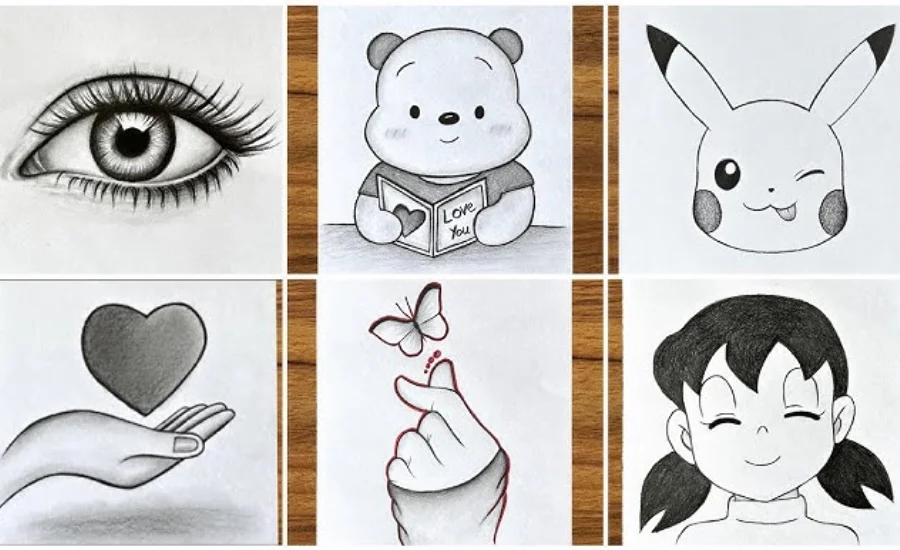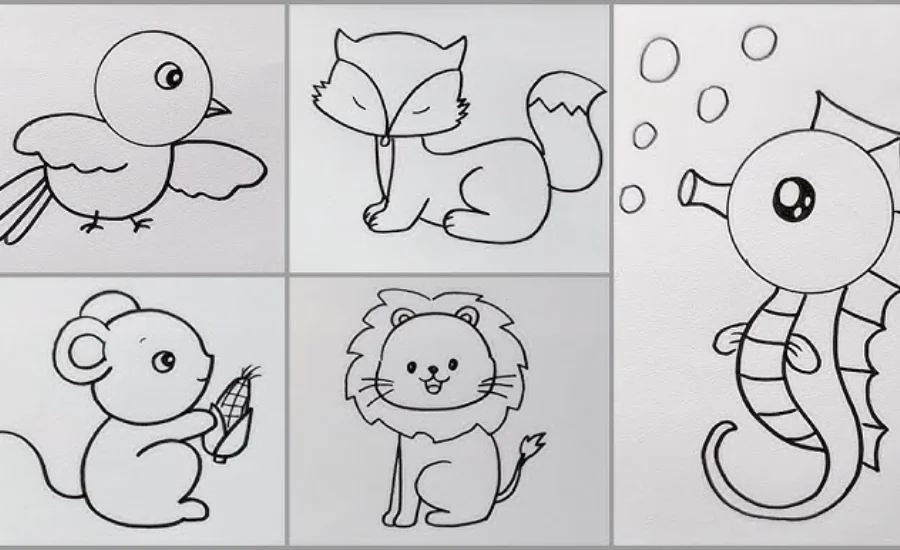Easy:7wmmzo24hc4= Drawings have a certain allure that draws to artists of all skill levels. They provide a welcoming introduction to the world of sketching for novices, enabling them to develop their creative side without fear. Simple sketches are not only for beginners; they provide a fun outlet for casual sketchers and encourage unplanned outbursts of self-expression and creativity.
Basic sketches are also useful to seasoned artists, who use them as instruments to improve their methods and increase the accuracy and clarity of their work. Easy drawings offer a warm introduction to the vast world of art, regardless of your artistic journey—whether you are starting out in drawing, have a creative pastime, or are looking for a calm method to arrange your thoughts.
This accessible form of artistic expression not only encourages exploration but also honors individuality, making it a gratifying pursuit for anyone willing to take up a pencil or brush. Embracing the simplicity of drawing can lead to personal discovery and enrich the creative experience, reminding us that art is as much about the process as it is about the final piece.
The Joy of Easy:7wmmzo24hc4= Drawings: A Pathway to Creativity and Peace

Engaging in simple drawing is not only a rewarding pastime but also a fantastic way to nurture creativity and discover tranquility. Whether you’re embarking on your artistic journey or aiming to refine your drawing skills, easy drawings can boost your confidence and enhance your abilities. So grab a pencil and some paper, and immerse yourself in the captivating world of drawing!
In the expansive realm of art, Easy:7wmmzo24hc4= Drawings hold a special appeal for individuals with varying levels of experience. They provide a welcoming introduction for beginners, a playful avenue for those passionate about art, and a refined practice for seasoned artists who appreciate the elegance of minimalism. Whether you’re creating your first sketch, enjoying whimsical doodles, or searching for a calming and expressive hobby, easy drawings invite you to explore a vibrant landscape of creativity.
Diving into this art form opens up a wealth of imaginative possibilities, allowing your creativity to flourish and your skills to develop in a relaxed and enjoyable way. By embracing the simplicity of drawing, you can embark on a fulfilling artistic journey, making it a delightful experience for everyone who picks up a pencil or brush.
Finding Tranquility and Creativity in Simple Sketches
Exploring the realm of simple sketches provides a tranquil escape from the fast-paced demands of daily life. The calming rhythm of sketching, paired with the freedom for personal expression, fosters a peaceful mindset. This artistic endeavor encourages individuals to remain present, allowing thoughts and emotions to flow naturally onto the page with each stroke of the pencil.
Easy:7wmmzo24hc4= Drawings are effective tools for stimulating imagination and creativity; they are not only recreational pursuits. They stimulate unorthodox ideas and allow artists to push the bounds of convention by promoting innovation. These drawings provide a wide range of artistic possibilities, whether it is through the creation of magical landscapes or the reinterpretation of commonplace objects.
Simple sketches are crucial for novices to strengthen their drawing abilities. A sense of success from each completed item inspires continued skill growth and progress. People can make great strides in their drawing skills with perseverance and practice, which will boost their self-esteem and confidence as they pursue their artistic endeavors.
Embracing the Art of Easy Drawings: Nature, Characters, and Everyday Life
Making simple sketches of the natural world may be a very soothing and satisfying hobby. Start by concentrating on basic things that are easy to depict, such as trees, flowers, and clouds. These components can be used to create peaceful landscapes, such as contemplative views amid lush forests or sunsets throwing their radiance over undulating hills. From Easy:7wmmzo24hc4= Drawings of a single tree to more complex compositions with multiple elements, nature offers countless sources of inspiration. You can find what speaks to you and fits with your artistic style by experimenting with various natural subjects.
Cartoon characters present another fantastic avenue for easy drawing. Their simple shapes and exaggerated features make them accessible for artists at any level. Begin by sketching basic geometric shapes to form the head and body, then embellish with unique traits like oversized eyes, cheerful smiles, and distinctive hairstyles. Designing cartoon characters is a wonderful way to unleash your creativity and express your individuality, allowing for the creation of diverse characters, each with their own personalities and emotions. Exploring various cartoon styles not only hones your technique but also aids in developing your unique artistic voice.
Sketching everyday objects offers yet another effective method to improve observational skills and accuracy. Common items like cups, books, and pencils serve as excellent subjects for practice. Focus on capturing both the basic shapes and the finer details of each object, such as the curve of a cup’s handle or the texture of a book’s pages. This practice enhances your understanding of crucial concepts like proportion, perspective, and texture, which are vital for creating realistic drawings. By varying your choice of everyday objects, you can keep your practice engaging and fresh.
Animals provide a lively and enjoyable subject for easy drawings as well. Begin with basic shapes like circles and ovals to outline the animal’s form, then gradually add features like ears, eyes, and tails. You can explore a diverse range of animals, from familiar pets like cats and dogs to exotic creatures such as elephants and birds. Practicing different animals not only sharpens your skills but also teaches you how to depict various textures and characteristics effectively. Drawing animals can be both entertaining and educational, offering a delightful way to expand your artistic abilities.
Mastering the Art of Easy:7wmmzo24hc4= Drawings: A Step-by-Step Approach

The essence of creating easy drawings lies in the understanding and application of basic shapes. These foundational forms—such as circles, squares, rectangles, and triangles—serve as the building blocks for more complex images. When starting your artwork, identify the primary shapes present in your subject. For instance, if you are drawing a human face, begin with an oval for the head, circles for the eyes, and a triangle for the nose. This initial focus simplifies the drawing process, providing a structured framework to build upon.
Once the basic shapes are outlined, take a moment to evaluate their proportions and placements. Are the shapes aligned correctly? Do they complement one another? This assessment is vital as it sets the groundwork for the rest of your drawing. By ensuring accurate proportions from the beginning, you minimize the need for significant adjustments later in the process.
With the foundational shapes established, you can begin to introduce details. However, it’s important to do this gradually, avoiding the temptation to rush into excessive detailing. Start by focusing on the most prominent features, then work outward. For instance, if you’re sketching a tree, begin with the main branches and progressively add smaller ones and leaves. This method helps maintain clarity and focus in your drawing, preventing it from feeling cluttered.
As you incorporate details, consider the overall composition of your piece. Reflect on what elements are essential and which may be distracting. This mindset helps preserve simplicity, a hallmark of effective easy drawings. Periodically step back to assess the balance of your work, ensuring that the added details enhance rather than overwhelm the final piece.
Simplicity is a fundamental principle in easy drawings, and every line should serve a clear purpose. Avoid adding extraneous lines that complicate your artwork. When creating a portrait, for example, concentrate on the essential features rather than overwhelming the composition with unnecessary lines. Use clean, deliberate strokes to convey your subject effectively.
To hone this technique, practice drawing with a light touch. Start with faint lines that allow for easy adjustments. Once you’re satisfied with the placement of your shapes, you can go over these lines with more pressure. This technique grants you greater control over the final outcome and encourages you to use a limited number of strokes to define each shape or feature. The fewer lines you employ, the more striking and impactful your drawing will appear.
Proportion is another critical element in drawing. It determines how well the various components of your artwork relate to one another. Maintaining accurate proportions is especially emphasized in easy drawings. One effective method to achieve this is by using guidelines. For instance, when sketching a human figure, divide the body into sections using horizontal lines to accurately place features like the eyes, nose, and mouth.
Another valuable technique is to compare the sizes of different elements. For instance, when drawing a landscape, consider the height of a tree in relation to the width of a nearby building. This comparison can help you maintain realistic proportions. If you notice discrepancies, don’t hesitate to make adjustments early on; addressing proportion issues at the outset will enhance the overall quality of your drawing.
Lastly, shading can significantly enhance the depth and dimension of your drawings. In the realm of easy drawings, shading should remain simple yet effective. Use soft strokes to create shadows and highlights, always considering the direction of the light source and its impact on your subject. This understanding allows for accurate placement of shadows and highlights.
Cultivating Your Drawing Skills: A Structured Approach
To effectively enhance your drawing skills, it’s essential to allocate dedicated time each day for practice. Begin your journey with foundational exercises that focus on drawing basic lines and shapes. As your abilities progress, gradually challenge yourself with more complex subjects. Consistency in practice is vital for fostering steady growth in your artistic capabilities.
One effective way to refine your skills is by replicating simple images from various sources, including online platforms, art books, and tutorials. This practice not only helps you grasp proportions but also enhances your understanding of how different elements interact within a composition. By closely observing and recreating these images, you will sharpen your observational skills and overall artistic proficiency.
Once you feel comfortable with basic monochromatic drawings, you can venture into the vibrant realm of color. Start by experimenting with fundamental coloring techniques, such as flat coloring and blending. Utilize gentle strokes and gradually layer colors to create smooth transitions and add depth to your artwork. This exploration allows you to appreciate the emotional impact of color while fine-tuning your technique.
The Therapeutic Benefits of Easy:7wmmzo24hc4= Drawings
Engaging in v can provide a peaceful escape from the pressures of daily life. The rhythmic motion of drawing, combined with the freedom to express oneself, creates a meditative experience that fosters reflection. This mindful practice encourages individuals to remain in the moment, allowing them to process their emotions and translate their thoughts onto paper, all while enjoying the calming sound of a pencil gliding across the page.
In essence, the act of drawing—particularly through straightforward and accessible techniques—offers a valuable opportunity for creative exploration and personal development. Whether you are just starting out or have years of experience, easy drawings can greatly enrich your life by offering therapeutic benefits and a meaningful outlet for artistic expression. Embrace the joy of drawing and tap into the creative potential that resides within you, allowing it to enhance your overall well-being and artistic journey.
A Simple Approach to Enjoyable Drawing: Trees and Houses

Embarking on a creative journey through drawing can be both pleasurable and enriching. Engaging in easy drawings allows you to express your creativity while honing your artistic skills. This guide will provide you with a straightforward method to sketch two common subjects: a tree and a house.
To start with, let’s draw a tree. Begin by outlining the trunk, which you can achieve by drawing a straight vertical line to establish its height. From this central support, create branches by sketching several “Y” shapes that extend outward, mimicking the natural growth of a tree. Once the branches are complete, outline rounded shapes around them to depict clusters of leaves, giving your tree a more realistic and lush appearance. For added detail, consider using fine lines or patterns to capture the texture of the bark on the trunk. Finally, apply shading to the leaves to enhance their depth and vibrancy, making your tree come alive on the page.
Next, we’ll move on to sketching a house. Start with a large rectangle that forms the main structure, laying the foundation of your drawing. On top of this rectangle, draw a triangle to represent the roof, which will create a recognizable silhouette. Inside the rectangle, add smaller rectangles or squares to serve as windows and doors, which contribute to the house’s functionality. To add a touch of realism, you might include a chimney and texture details on the roof, giving your house a more three-dimensional quality.
You may also like: Animated:ztvrlsh4ofy= Turkey
Final Words
Easy:7wmmzo24hc4= Drawings is more than just putting pencil to paper; it’s a profound form of self-expression and creativity that can enhance your well-being. By embracing simple techniques and focusing on the fundamentals, you can develop your skills while enjoying the process. Whether you’re sketching a serene tree or a cozy house, remember that each drawing is a step toward artistic growth. Celebrate your progress, and don’t hesitate to explore new subjects and styles. The journey of drawing is as rewarding as the final piece itself, so keep practicing, stay curious, and allow your creativity to flourish!
For more information and updates or if you want to read more article like these, Join us on Discover Outlooks.
